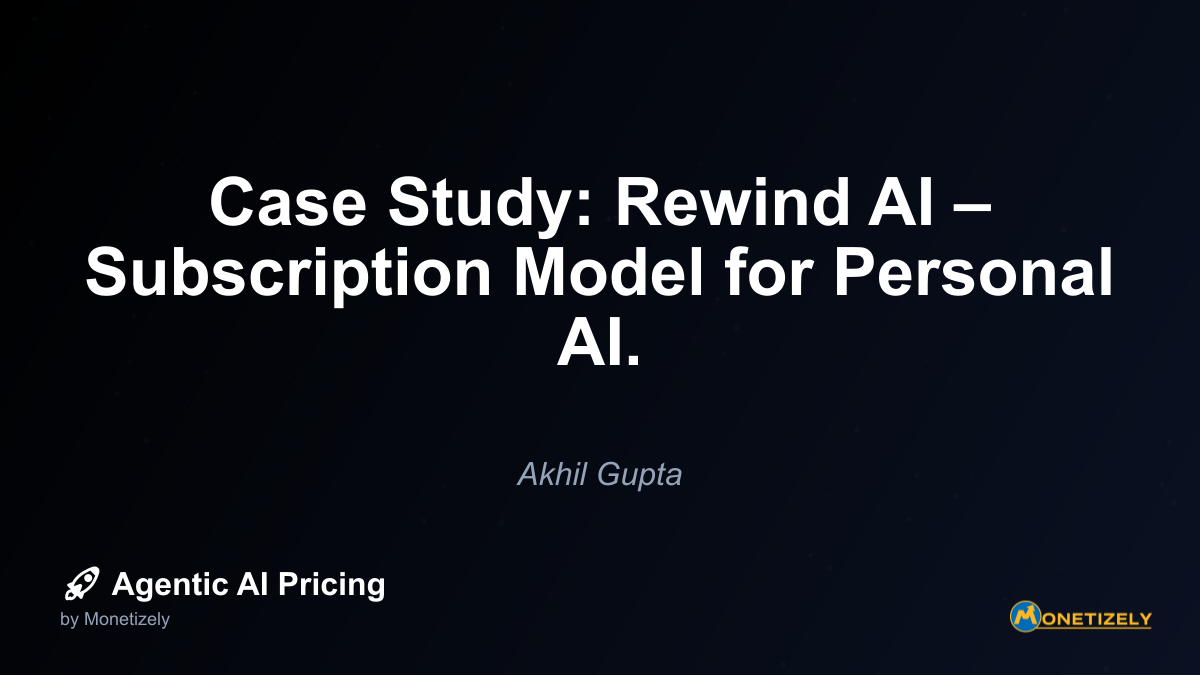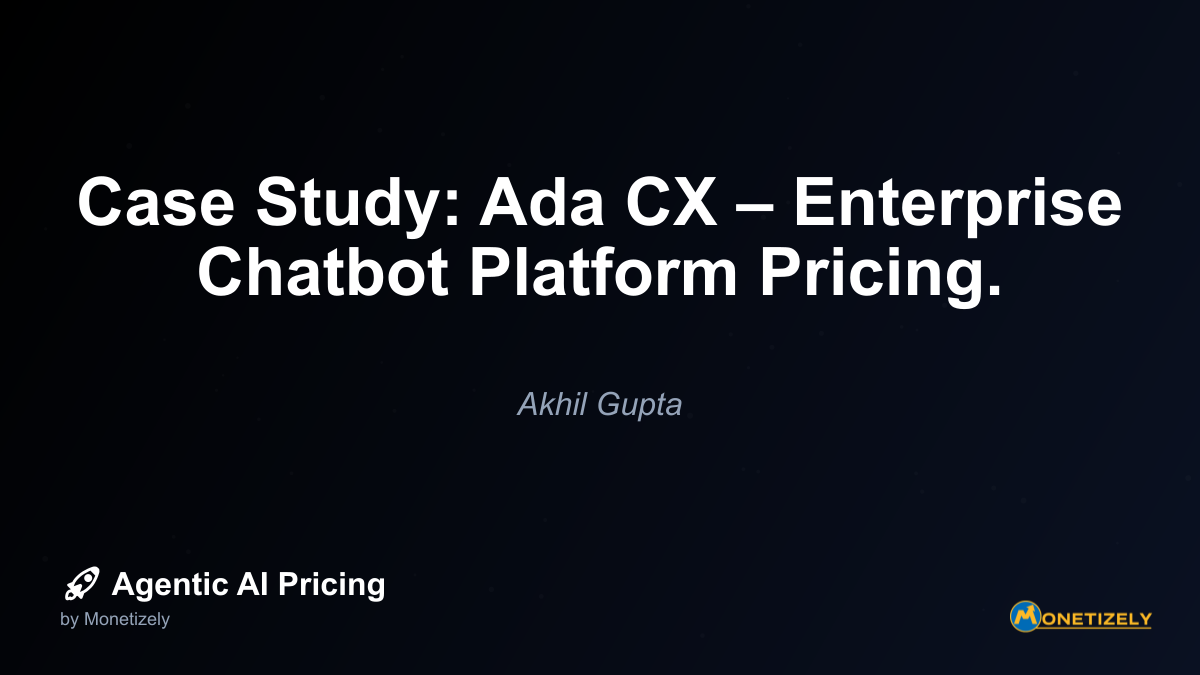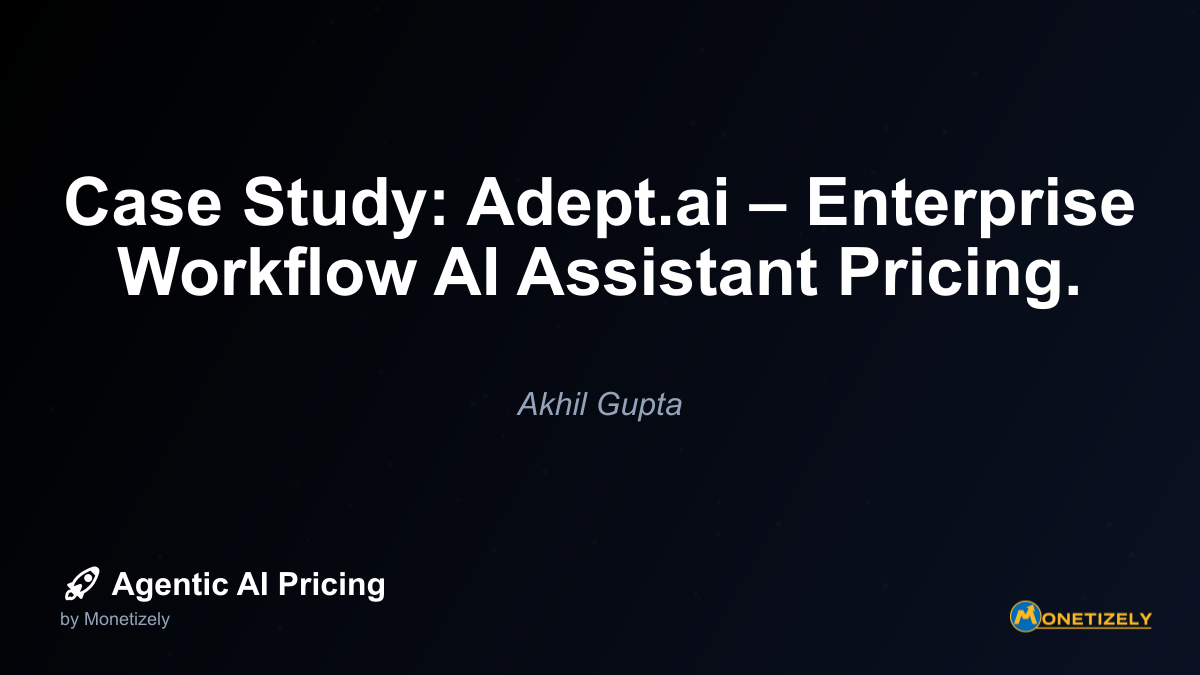· Akhil Gupta · Case Studies · 7 min read
Case Study: Rewind AI – Subscription Model for Personal AI.
AI and SaaS Pricing Masterclass
Learn the art of strategic pricing directly from industry experts. Our comprehensive course provides frameworks and methodologies for optimizing your pricing strategy in the evolving AI landscape. Earn a professional certification that can be imported directly to your LinkedIn profile.

Comparing Rewind’s Approach to Alternative AI Pricing Models
Rewind’s subscription model represents just one approach in the broader landscape of AI pricing strategies. Subscription versus usage-based pricing represents one of the fundamental decisions facing AI companies today.
Subscription vs. Usage-Based Alternatives
While Rewind opted for a straightforward subscription, other AI tools employ different models:
- Usage-based pricing: Charging based on computational resources consumed or queries processed
- Freemium with premium features: Basic functionality free with advanced capabilities behind a paywall
- One-time purchase with optional add-ons: Initial purchase with expansion options
- Tiered access by capability: Different price points for increasing AI capabilities
Rewind’s choice of subscription over usage-based pricing likely stems from several factors:
- Predictable costs for users: Fixed monthly fee regardless of usage intensity
- Simplified user experience: No need to monitor consumption or worry about unexpected charges
- Predictable revenue for the company: More stable income forecasting than usage-based alternatives
- Alignment with continuous value delivery: The service provides ongoing benefit regardless of active query volume
For personal productivity tools like Rewind, subscription often proves more appropriate than usage-based models, which can create anxiety about costs and discourage the very usage that delivers value.
Technical Infrastructure and Cost Structure
Understanding Rewind’s pricing strategy requires examining the underlying technical requirements and associated costs that must be covered through subscription revenue.
Computational Requirements
Rewind’s functionality demands significant computational resources:
- Real-time processing: Continuously analyzing screen content requires substantial CPU/GPU resources
- Local storage management: Efficiently storing and indexing massive amounts of visual data
- Search optimization: Creating and maintaining searchable indexes of all captured content
- AI model operation: Running sophisticated machine learning models locally rather than in the cloud
These requirements necessitate substantial ongoing development investment, justifying the recurring revenue model rather than one-time purchase.
Storage Considerations
The storage requirements for Rewind present particular challenges:
- Exponential growth: User data accumulates continuously, creating expanding storage needs
- Retention policies: Balancing comprehensive history with practical storage limitations
- Compression technologies: Developing efficient storage mechanisms to maximize history while minimizing footprint
- Local device constraints: Working within the limitations of user devices rather than scalable cloud infrastructure
The subscription model allows Rewind to manage these challenges by tying storage allowances to subscription tiers, creating natural limitations that make the service technically sustainable.
User Adoption Challenges and Solutions
Despite its compelling value proposition, Rewind faces several adoption challenges that influence its pricing strategy:
Privacy Concerns and Education
The nature of the service—recording everything on screen—raises immediate privacy concerns for potential users. Rewind addresses these through:
- Educational content: Explaining the on-device processing model
- Transparent policies: Clearly communicating data handling practices
- Control features: Providing easy ways to pause recording or exclude sensitive applications
- Trust building: Establishing reputation through security audits and privacy commitments
The subscription pricing reinforces this education by positioning privacy as a premium feature worth paying for rather than a secondary consideration.
Habit Formation and Onboarding
For users to realize value, they must integrate Rewind into their daily workflow. The subscription model supports this through:
- Free trial periods: Allowing users to experience value before committing financially
- Gradual onboarding: Teaching users how to incorporate the tool into their workflow
- Value demonstration: Showing specific examples of time saved or information recovered
- Usage incentives: Encouraging regular use to justify the subscription investment
This focus on habit formation proves essential for reducing churn—the primary threat to subscription-based business models.
Future Evolution of Rewind’s Pricing Strategy
As Rewind matures and the personal AI market evolves, several potential pricing innovations may emerge:
Integration with Professional Tools
Expanding beyond individual users to team environments could open new pricing tiers:
- Workspace plans: Team-based subscriptions with collaborative features
- Enterprise licensing: Organization-wide deployment with administrative controls
- Professional vertical specialization: Tailored versions for specific industries with pricing adjusted to value delivered
These expansions would allow price differentiation based on professional versus personal use cases.
Feature-Based Segmentation
As the product matures, more sophisticated feature segmentation could emerge:
- AI capability tiers: Different levels of intelligence or analysis capabilities at different price points
- Integration capabilities: Premium pricing for connections to specialized tools and services
- Data retention policies: Tiered pricing based on how long information is preserved
- Advanced analytics: Premium insights about personal digital behavior patterns
This approach would allow Rewind to capture more value from power users while maintaining accessibility for casual users.
Hardware Integration Possibilities
Future versions might integrate more deeply with hardware, creating new pricing opportunities:
- Device bundles: Specialized hardware optimized for Rewind with bundled subscription
- Multi-device coverage: Premium tiers for recording across multiple devices
- Wearable integration: Expanding beyond screen recording to other personal data streams
These hardware integrations could justify premium pricing by expanding the scope of personal memory augmentation.
Lessons for Other AI Pricing Strategies
Rewind’s approach offers valuable insights for other companies developing consumer-facing AI tools:
1. Privacy as Premium Feature
Rewind demonstrates that privacy-preserving implementations can justify premium pricing, especially for AI applications handling sensitive personal data. This contradicts the common assumption that privacy features must come at the expense of business models.
2. Alignment with Value Perception
The subscription model aligns perfectly with how users perceive value from Rewind—as an ongoing service that becomes more valuable over time rather than a one-time utility. This alignment between pricing structure and value delivery timeline is crucial for AI tools.
3. Simplicity in User Experience
By avoiding usage-based metrics or complicated pricing structures, Rewind creates a frictionless experience where users can focus on benefits rather than costs. This simplicity proves particularly important for consumer AI tools where cognitive overhead should be minimized.
4. Transparent Value Exchange
The direct financial relationship establishes clear expectations: users pay for the service, and in return, they receive both functionality and privacy. This transparency builds trust in ways that more complex or opaque business models cannot.
The Broader Implications for Personal AI Pricing
Rewind’s case study reveals several important trends likely to influence personal AI pricing more broadly:
The Rise of Privacy-Centric Business Models
As privacy concerns grow, Rewind exemplifies how building privacy into both product architecture and business model can create sustainable competitive advantage. This approach may become increasingly necessary as regulations tighten and consumer awareness increases.
Consumer Willingness to Pay for AI Value
Rewind’s success challenges assumptions that consumers expect AI tools to be free. When value is clearly demonstrated and privacy concerns addressed, users appear willing to pay subscription prices comparable to other premium productivity tools.
The Importance of Trust in AI Adoption
Perhaps most significantly, Rewind illustrates how pricing strategy contributes to trust building. By creating a straightforward financial relationship rather than hidden monetization methods, the company establishes the foundation for long-term user relationships.
Conclusion
Rewind AI’s subscription model offers a compelling case study in how consumer-facing AI tools can create sustainable business models while addressing privacy concerns. By positioning their technology as a premium productivity enhancement worthy of ongoing investment, they’ve established a clear value exchange that respects user privacy while generating predictable revenue.
The success of this approach suggests that as personal AI tools become more sophisticated and integrated into our digital lives, subscription models may become the dominant paradigm—particularly for applications that combine high utility with sensitive data handling. Rather than racing to the bottom with free, ad-supported models that inevitably compromise privacy, Rewind demonstrates how charging directly for value can create healthier alignment between company incentives and user interests.
For other companies developing AI tools, Rewind’s example highlights the importance of aligning pricing structure with value delivery timeline, privacy considerations, and user experience. As the personal AI market matures, those who establish transparent, trust-building business models may ultimately gain competitive advantage over those relying on less straightforward monetization approaches.
The ultimate lesson from Rewind’s pricing strategy may be that when AI truly augments human capabilities in meaningful ways, users will pay for that value—particularly when the financial relationship is straightforward and respects their privacy and agency.
Co-Founder & COO
Akhil is an Engineering leader with over 16+ years of experience in building, managing and scaling web-scale, high throughput enterprise applications and teams. He has worked with and led technology teams at FabAlley, BuildSupply and Healthians. He is a graduate from Delhi College of Engineering and UC Berkeley certified CTO.
Pricing Strategy Audit
Let our experts analyze your current pricing strategy and identify opportunities for improvement. Our data-driven assessment will help you unlock untapped revenue potential and optimize your AI pricing approach.




